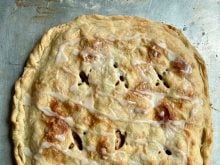Recently I returned to my grandmother’s garden. I spent many happy hours there as a child, helping my mother, grandmother and aunt pick raspberries, red and black currants, apples, plums and strawberries.
The garden fascinated me as a child because it was like a woodland world magically planted on the bald Saskatchewan prairie south of Regina. The natural surrounding landscape is treeless and tabletop flat for miles. Yet my grandparents painstakingly watered and nurtured a carragana hedge to surround their garden and provide a cool, green, woodland oasis.
Read Also

Support needed at all levels for high-value solar projects
Farmers, rural municipalities and governments should welcome any opportunity to get involved in large-scale solar power installations, say agrivoltaics proponents.
As I returned to the garden a couple of weeks ago to attend a cousin’s wedding, I was overcome with nostalgia and tranquillity. I shared my feelings with another cousin who also remembered playing and working in the garden with me and our elders.
The garden has been changed but only for the better. Part of one side of the hedge has been removed so the garden can be appreciated and enjoyed from the house.
My aunt and uncle were also experiencing nostalgic feelings as they witnessed their granddaughter’s wedding and remembered their own wedding day 64 years ago in this house and garden. It was a special day and I want to thank the young couple for allowing me to relive the past, enjoy the present and wish them well for the future.
Reader request
Dear TEAM: I’m looking for a pattern that came out in 1998 from the Patons and Baldwin yarn company. I believe it is now part of Spinrite. The pattern is for a leaf rib pullover made with supersoft D.K. yarn. This pattern could also be in a Patons and Baldwin knitting book but so far I have not found it in any I’ve looked at. Does anyone have a 1-800 number for Patons and Baldwins? I would be happy to pay for this pattern. – E.D., High Prairie, Alta.
Remaking soft jelly or jam
Last year when I was making crabapple jelly, one of the batches did not set. Bernardin’s Jams and Jellies booklet provided me with guidelines for remaking my soft jelly.
Unique circumstances such as growing conditions, the fruit variety or the fruit itself may require more than 24 hours for a gel to form. Wait two weeks to see if the product will gel. During this time do not disturb or shake it. If after two weeks the product still has not jelled, it may be recooked.
Only remake products that have maintained a good seal. First, make one trial batch using one cup (250 mL) of unset product to ensure success. Do not recook more than eight cups (two L) at one time.
All remade jams and jellies must be processed in a boiling-water canner to assure good vacuum seals and to destroy microorganisms that can cause food spoilage.
Remade jam with powdered fruit pectin
Measure unset jam/jelly to be
remade. For each cup (250 mL) of product, measure:
2 tablespoons 30 mL
granulated sugar
1 tablespoon water 15 mL
1 1/2 teaspoons 7 mL
fruit pectin
In a large, deep stainless steel saucepan, whisk fruit pectin into water, stirring constantly to prevent scorching. Bring to a boil. Stir in the measured jam and sugar.
Stirring constantly over high heat, bring to a full rolling boil; boil hard for 30 seconds. Remove from heat. Skim foam, if necessary.
Ladle into hot sterilized jars, leaving quarter inch (0.5 cm) headspace. Remove air bubbles. Wipe jar rim removing any stickiness. Centre new snap lids on jars; apply screwbands securely until fingertip tight. Heat process for five minutes in boiling water canner.
Remade jam, liquid pectin
Measure unset product and place in a large, deep stainless steel saucepan. For each cup (250 mL) of unset product, measure and set aside:
3 tablespoons 45 mL
granulated sugar
1 1/2 teaspoons lemon 7 mL
juice
1 1/2 teaspoons 7 mL
liquid pectin
Stirring constantly over high heat, bring product to a boil. Add sugar, lemon juice and liquid pectin.
Stirring constantly, return mixture to a full rolling boil. Boil hard one minute. Remove from heat. Skim foam, if necessary. Ladle into hot sterilized jars, and follow instructions as in previous recipe.
Antipasto warning
This is the season of the year when you may be planning to make antipasto using fresh garden produce. Many home canners believe they can preserve their special recipe of antipasto at home by simply preparing the recipe, putting it in jars and sealing them.
The freshly prepared recipe might be delicious, but the home canned version could be dangerous.
Antipasto recipes were designed to be mixed and served, not preserved, warn the staff of Bernardin, the manufacturer of canning jars and lids. Most traditional antipasto recipes cannot be home canned safely and successfully.
Such recipes combine fish, vegetables and olives – all low acid foods that require lengthy processing at high temperatures in a pressure canner to destroy potentially harmful bacteria spores.
When processed for the required time, the resulting antipasto might be “safe” but would be unacceptable in texture and taste.
Some consumers believe that using previously canned ingredients – anchovies, olives, salmon – overrides the necessity of processing the completed recipe. Not so. Heat processing only works when filled jars of the complete recipe are heat processed by the appropriate method and time. But this doesn’t mean delicious antipasto can’t be safely preserved at home.
Home economists at Bernardin have developed a flavourful recipe with a varied texture that can be safely preserved in a boiling water canner. While this vegetarian antipasto is delicious served as is, it’s also a great base for adding personal touches at serving time. Add individual canned components like salmon, tuna, olives, mushrooms or a splash of special olive oil.
This antipasto is formulated to allow low acid vegetables to be processed safely in a boil water canner. Do not alter ingredients or amounts.
Vegetarian antipasto
6-7 pint jars 500 mL
2 1/2 cups green beans 625 mL
cut into half inch (1 cm)
pieces, about 400 g
2 1/2 cups cauliflower 625 mL
florets
2 cups diced onion 500 mL
2 cups diced green 500 mL
pepper
2 cups diced red 500 mL
pepper
1 1/2 cups diced carrots 375 mL
1 1/2 cups diced celery 375 mL
2 cups lightly packed 500 mL
brown sugar
3 tablespoons pickling 45 mL
salt
2 cups red wine 500 mL
vinegar
3 cans (156 mL each)
tomato paste
4 tablespoons 60 mL
worcestershire sauce
2 tablespoons hot 30 mL
pepper sauce
4 garlic cloves, minced
2 cups diced, peeled 500 mL
eggplant or unpeeled
zucchini
3 tablespoons dried 45 mL
basil
1 tablespoon dried 15 mL
mustard
Place seven clean 500 mL mason jars in a boiling water canner. Fill with water and bring to a rolling boil. Boil snap lids five minutes – not longer – to soften sealing compound.
Prepare, measure and combine vegetables, except eggplant. Set aside.
Combine brown sugar, salt, vinegar, tomato paste, worcestershire and hot pepper sauces and garlic in a large, deep stainless steel saucepan. Stirring occasionally, bring to a boil.
Prepare eggplant. Stir eggplant, basil and mustard into hot sauce with remaining vegetables. Stirring occasionally, return mixture to a boil. Boil gently for five minutes to soften the vegetables.
Ladle hot mixture into a hot jar to within half inch (one cm) of the rim. Using nonmetallic utensil, remove air bubbles. Wipe jar rim removing any stickiness. Centre lid on jar and apply screwband until fingertip tight. Do not overtighten.
Place jar in canner. Repeat for remaining hot mixture.
Cover canner, return water to a boil. Process by boiling filled jars 25 minutes. Remove jars. Cool undisturbed 24 hours.
Check jar seals. Sealed lids curve downward. Remove screwbands, wipe and dry bands and jars. Label and store in a cool, dark place.














